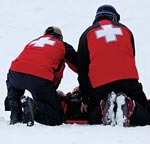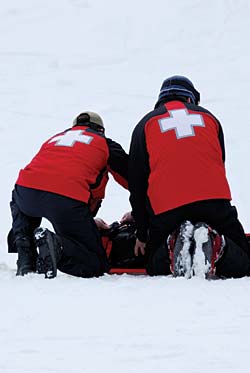
Real-Life Miracles
Vail Ski Resort deployed an AED one morning on a ski slope and recorded its first save with the device a few hours later.
- By Arthur Levy
- Jun 01, 2007
 ACCORDING to the American Heart
Association, more than one in three
American adults have one or more
types of cardiovascular disease. The
National Heart, Lung, and Blood Institute’s
Framingham Heart Study has followed
participants since 1948 and their offspring
since 1971. The study estimates the
overall lifetime risk of cardiovascular disease
(CVD) and found more than half of
men and nearly 40 percent of women in the
United States will develop CVD during
their lifetime.
ACCORDING to the American Heart
Association, more than one in three
American adults have one or more
types of cardiovascular disease. The
National Heart, Lung, and Blood Institute’s
Framingham Heart Study has followed
participants since 1948 and their offspring
since 1971. The study estimates the
overall lifetime risk of cardiovascular disease
(CVD) and found more than half of
men and nearly 40 percent of women in the
United States will develop CVD during
their lifetime.
Nearly 2,400 Americans die of CVD
each day, according to AHA. CVD claims
more lives each year than cancer, chronic
lower respiratory disease, accidents, and
diabetes mellitus combined.
“We are getting better and better
testing to allow us to screen populations
for families with risk of heart disease,
people with elevated cholesterol, people
who smoke—to find out, first of all,
whether they are at risk for having heart
disease. And, secondly, if they do have
heart disease, then we can address the risk
of Sudden Cardiac Death as the first
symptom,” said Dr. Nelson Trujillo, an
interventional cardiologist in Boulder,
Colo. “We hope that people will have
symptoms,” Trujillo added. That’s because
for more than half of the people who have
a heart attack, the first presentation is that
event, “and in that group a number of
people will die suddenly as the first
symptom of their heart disease,” he said.
Screening for heart disease includes
blood tests, stress test, electrocardiograms
(EKGs), and imaging such as calcium
scores that indicate heart disease. Treatment
may range from a change in lifestyle,
such as diet and exercise, to taking medications
such as Statin drugs, which
reduce cholesterol.
Sudden Cardiac Arrest (SCA)
causes 300,000 to 400,000 deaths in
the United States each year. On
average, 27.4 percent of out-of-hospital
cardiac arrests receive bystander
cardiopulmonary resuscitation. SCA
most frequently occurs in adults in
their mid-30s to mid-40s, and it
affects men twice as often as it does
women. SCD is rare in children,
affecting only 1 to 2 per 100,000 children
each year. Children can go into
SCA, however, from trauma related
to sports injuries and congenital heart
abnormalities. Estimates are 200 to
400 young U.S. athletes die on
playing fields of cardiac arrest each
year, but “we don’t have accurate
public health measures,” said Dr.
John P. Payne, director of cardiac
electrophysiology at the University of
Mississippi Medical Center. AHA
recommends screening for high
school and college athletes before
they compete, including a physical examination
plus a family history. Family history
is important, experts say, because many cardiomyopathies
are inherited. The use of
EKGs in screening athletes is currently
being debated; a recent study by Italian
physicians reported in the Journal of the
American Medical Association says the use
of an EKG in screening athletes has
reduced SCA events by 89 percent.
Causes and Treatments
SCA is not a heart attack. A heart attack is
a “plumbing problem” that occurs when
one or more arteries of the heart is blocked,
preventing the heart from receiving blood.
The lack of oxygen-rich blood can damage
the heart muscle. SCA is an “electrical
problem.” AHA defines Sudden Cardiac
Death, or cardiac arrest, as the sudden,
abrupt loss of heart function in a person
who may or may not have diagnosed heart
disease. The time and mode of death are
unexpected. It occurs instantly or shortly
after symptoms appear. The most common
reason for patients to die suddenly is cardiovascular
disease—in particular, coronary
heart disease. About half of all deaths
from coronary heart disease are sudden and
unexpected, regardless of the underlying
disease; half of all deaths due to atherosclerosis
(arteries lined with fatty deposits) are
sudden. SCD is a major health problem
causing about 330,000 deaths each year
among U.S. adults before they reach either
a hospital or emergency room.
Other causes of SCA include electrocution,
drowning, choking, respiratory arrest,
viruses, and trauma.
SCA is treatable, but every secondcounts. AHA reports that about 80 percent
of SCA events occur in the home, almost
60 percent are witnessed, and 95 percent of
SCA victims die before reaching the hospital.
OSHA reports that more than 10,000
cases of SCA occur at work. If a person collapses
from SCA, brain damage can occur
in four to six minutes. CPR and defibrillation
using a portable automated external
defibrillator can save lives.
“Clearly, the best treatment for SCA is
electricity,” Trujillo said. “When we find a
person in SCA, we hope to find their heart
fibrillating—beating irregularly at such a
rate that it can’t pump blood effectively any
more. We can restore the heart’s rhythm
and ability to pump blood by applying an
electrical shock. The ability to defibrillate
the heart is our best chance to get that
person back.” He said he recommends that
many of his patients with diagnosed coronary
artery disease keep an AED in their
homes and have family members trained in
its use and in CPR.
As more and more AEDs are placed in
public shopping malls, buildings, schools,
and corporate offices, the public is aware
of their use to save lives. While the
number of AED saves grows, many
people are still unaware of the devices or
how to use them. Many people fear if
they use an AED, they may needlessly
shock a SCA victim. The fear can be alleviated
by training and knowledge about
how AEDs will shock only when the
device’s computer has determined there is
a need for a shock.
AEDs Used from Slopes to
Pipelines to Terminals
The Vail Ski Resort recently purchased several
additional AEDs for the ski patrol. An
AED was delivered one morning and
placed in service. Early that afternoon, a 67-
year-old man collapsed on the slopes. The
ski patrol arrived within minutes and used
the new AED to administrator a life-saving
shock. Vail has more than 70 staff members
trained in AED and CPR use, and AEDs
are placed throughout the ski area.
Suncor Energy maintains more than
390 miles of pipelines carrying crude oil
from Wyoming to its refinery near Denver.
Suncor has AEDs spread with its staff
along the pipeline, and these units must
function during emergencies amid the cold
and wind of winters and the hot blowing
dust of summers. Suncor also has AEDs at
its refinery and corporate office and has
trained its staff in their use.
Lt. Tim McGraw, a detective for the
University of Colorado Police Department,
was traveling through Hartsfield
Airport in Atlanta when he saw a man collapse
in the passenger terminal. A doctor
nearby also saw the man collapse and began
CPR. McGraw had seen AEDs in the terminal
and asked an airport employee to get
one while he joined in performing CPR.
When the AED arrived and the pads were
connected, the AED advised not to shock.
McGraw and the doctor continued CPR
and again checked the AED. This time, the
AED advised to shock the victim, and several
shocks were given. The shocks were
successful, and the man recovered.
All commercial aircraft now are
required to carry AEDs. American Airlines
was the first commercial airline to place
AED on all of its aircraft; American
reports 76 passengers on its flights have
been saved by an AED. American also has
AEDs installed on all floors of the corporate
office in Fort Worth, Texas, and at
maintenance facilities.
MedAire Corp. of Tempe, Ariz., provides
medical assistance to 90 commercial
airlines through its Global Response Centers.
When an in-flight medical problem
occurs, the centers can connect flight crews
with medical advice anywhere in the world.
Flight crews accessed AEDs 141 times
during 2006, the company reports.
Coronary artery disease is not the only
cause of SCA. Warren Heim of Boulder,
Colo., was in good health when his
occurred. He was at an athletic club with a
light workout planned in preparation for a
wrestling tournament the next day, and he
remembers starting to black out about after
running about 20 feet on the track. “It was
very acute, it was very intense,” Heim said
later, “like being on a couch and getting up
suddenly where you start to black out.” He
lay on his back on the track, moving in and
out of consciousness. The club had no
AED at that time, so 911 was called. An
ambulance was in the neighborhood and
arrived within minutes.
“As soon as the ambulance crew arrived,
a wave of darkness rolled over me from my
knees to my head,” Heim recalled. He
regained consciousness hearing paramedics
saying his heart had stopped and was
restarted. The next thing he recalls was
waking up in the intensive care unit at a
local hospital more than three hours later.
Heim learned later that he had another
sudden cardiac arrest episode in the
ambulance. His cardiac arrest was caused
by a virus.
Testing Standards for Harsh Environments
AEDs must be able to operate safely in any
environment, including rain, snow, and
temperature extremes. An international
standard, IEC 529, is used to identify the
level of protection provided by a defibrillator’s
enclosure against solid particles and
water. If your company purchases an AED,
check the manufacturer’s technical specifications
to make sure the device will
operate in any environment.
IPX1 testing includes testing an AED
by simulating rain falling on the device at a
rate of 2.4 inches per hour. IPX4 testing
places an AED in an enclosed chamber
where water is sprayed on all sides for 10
minutes. In IPX5 testing, the AED is
sprayed on all sides with pressurized water
using a calibrated nozzle for three minutes.
Other IPX testing ratings are for dust
particle size.
This article originally appeared in the June 2007 issue of Occupational Health & Safety.